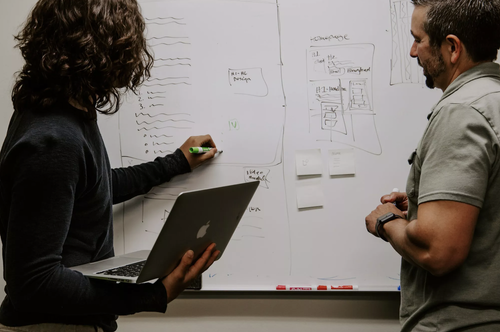Coaching in the workplace isn’t working the way it should.
At least, not for most teams.
Over the last decade, workplaces have changed dramatically. Teams are more distributed. Change is relentless. Employees want more support—but they aren’t getting the coaching they need to grow.
And yet, many organizations still approach coaching like they did in 2010.
- Coaching is reserved for executives while managers and employees miss out on meaningful development.
- Coaching happens outside of daily work, making it difficult for employees to apply what they learn.
- Managers are expected to carry the full weight of coaching—without enough support or tools to make it sustainable.
Leaders aren’t ignoring coaching. They’re investing in it, making time for it, and trying to do it well. But despite those efforts, coaching often feels inconsistent, unsustainable, or limited in impact.
It’s not because coaching isn’t valuable. It’s because the way it’s being delivered isn’t built for today’s workplace.
Instead of coaching being event-based, time-bound, and exclusive, it needs to be woven into everyday interactions—accessible to everyone when they need it most.
To make that shift, coaching needs to:
- Reach beyond leadership circles and become a company-wide practice.
- Happen in the moments that matter—before key conversations, during collaboration, and as challenges arise.
- Be scalable—so coaching isn’t another burden on HR or managers but a shared practice that strengthens teams.
Coaching shouldn’t feel like adding more work. It can be your team’s most valuable tool—when it’s done differently.
👉 So, what needs to change? Let’s break it down.
See How Cloverleaf Scales Coaching In The Workplace
Why Coaching Is Different From Other Management Strategies & Why It Is More Effective
Workplace challenges today aren’t the same as they were 10 years ago. But most leadership coaching models haven’t changed to match them.
Managers are expected to motivate, engage, and grow their teams, but they’re still being taught an outdated approach:
Management is about control, while coaching is about discovery.
- The old-school management model is directive—leaders assign tasks, monitor progress, and correct mistakes.
- Coaching, on the other hand, encourages employees to explore solutions, ask questions, and take ownership.
Managing focus on execution while coaching builds problem-solvers.
Coaching leads to success because it facilitates psychological capital, a positive psychological resource that coachees can apply to their day-to-day work experiences. – psychologytoday.com
- Management ensures work gets done. Coaching ensures employees know how to think through challenges independently.
- In today’s fast-moving, constantly shifting workplace, employees need to be adaptable, not just productive.
Coaching must evolve beyond a top-down model.
- Coaching shouldn’t just be a leader-to-employee activity—teams grow best when development happens across all levels, not just when managers make time for it.
- Relying solely on managers for coaching slows down team development and prevents employees from learning alongside one another.
What’s the shift?
Coaching should be a shared team practice—accessible to everyone, not just leaders, and embedded into daily work rather than relying solely on managers to drive it.

Why 2010-Era Coaching Is Holding Your Team Back
Coaching has always been a valuable part of leadership and team development. But in many organizations, it hasn’t evolved alongside the workplace itself.
Teams operate differently than they did a decade ago—communication is faster, collaboration is more fluid, and challenges emerge in the moment. Yet, many companies still use program models that don’t match today’s realities.
Instead of helping teams grow together, coaching often is:
- Exclusive – Reserved for executives and high-potential employees, leaving most managers and team members without meaningful support.
- Disconnected from daily work – Delivered through workshops, quarterly reviews, or one-off training sessions that quickly fade from memory.
- Overly dependent on managers – Coaching is framed as a leadership responsibility rather than an organization-wide practice.
It’s not that these methods never worked—it’s that they were built for a different kind of workplace.
Three Major Gaps in Traditional Coaching
1. It’s Exclusive—Only Leaders Get Coached
Most coaching is designed for senior executives or “high-potential” employees. Managers and employees—who would benefit the most—are left without meaningful development opportunities.
- The problem: When coaching is limited to a select few, teams lose out on daily opportunities for growth.
- The impact:
- 68% of managers have never received formal leadership training, leading to misalignment, disengagement, and poor team performance.
- Employees receive little to no coaching unless they are identified as high-potential, which can lead to a lack of motivation and unclear career development.
2. It’s Disconnected—Training Happens Away from Real Work
Most coaching and leadership training happens in scheduled sessions or offsite programs. But by the time employees return to their day-to-day work, much of what they learned is forgotten or never applied.
- The problem: Coaching is treated as an event rather than something employees can apply in their daily roles.
- The impact:
- 90% of what people learn in training is forgotten within a month without reinforcement.
- Employees lack support when they need it most—before key conversations, during challenges, or when giving feedback.
3. It Overloads Managers—Too Much Pressure, Not Enough Support
Managers are expected to drive all coaching and development for their teams, yet they are already juggling multiple responsibilities. Without the right tools and shared accountability, coaching becomes another overwhelming task.
- The problem: When coaching is only a manager’s responsibility, it doesn’t get the attention it deserves.
- The impact:
- Managers struggle to balance coaching with other demands, leading to inconsistent application.
- Employees don’t receive consistent feedback or growth opportunities because coaching isn’t built into the team’s daily interactions.
Coaching is meant to unlock potential—but when it’s tied to outdated structures, that potential stays untapped.
If coaching isn’t embedded in how teams work together every day, it becomes another initiative instead of a real driver of growth.
So, what does modern, scalable coaching look like?
Let’s break it down.
The Future of Coaching in the Workplace: Scalable, Embedded, and Team-Driven
Workplace coaching is at an inflection point. Organizations are investing more in coaching than ever before—yet many employees still aren’t receiving the development they need.
A recent study found that 9 out of 10 companies plan to increase their investment in coaching over the next 12 months. But if coaching remains exclusive, disconnected from daily work, and overly reliant on managers, those investments won’t create the lasting impact organizations expect.
Coaching isn’t just an HR initiative or a leadership skill—it should be a shared, everyday practice that strengthens teams at every level.
What Needs to Change?
For coaching to drive real results, it must move beyond traditional approaches that limit its reach and effectiveness. Here’s what needs to happen:
- Coaching must be available to every employee, not just a select few. Too often, coaching is reserved for senior leaders or high-potential employees, leaving the majority of the workforce without meaningful development.
- It must be part of daily work—not something that happens in training rooms or scheduled sessions. Coaching that only occurs in structured programs often fails to translate into long-term behavior change.
- It must be shared—coaching isn’t something managers should have to carry alone. When employees learn how to coach and support each other, development becomes a continuous, team-driven process.
A recent Harvard Business Review article reinforces this shift, advocating for leaders to act as coaches and integrate development into daily interactions rather than treating it as a separate function.
How Coaching Must Evolve
Many organizations recognize the need for coaching but are still using outdated strategies. Here’s what’s changing:
- From Leadership-Only → Teamwide Development
- Coaching should extend beyond managers to become a team practice that helps everyone improve.
- From Generalized Training → Personalized, Context-Aware Coaching
- Employees need coaching that is relevant to their work, strengths, and challenges—not just one-size-fits-all advice.
- From Training Events → Coaching in the Flow of Work
- Development needs to happen in the moment, guiding employees before key conversations, collaboration, or decision-making.
Organizations that make these shifts will create a workplace where coaching isn’t just an occasional intervention—it’s a continuous driver of team success.
Coaching That Fits Today’s Workplace
Coaching doesn’t have to be another task on a manager’s plate or a one-off training initiative. It can be woven into how teams work, learn, and grow together.
Companies that embrace scalable, embedded coaching will see stronger teams, greater agility, and a workforce that continuously improves—without adding to the burden of HR or leadership.
How to Make Coaching Scalable, Personalized, and Embedded in Workflows
To truly transform coaching in the workplace, organizations need a strategy that makes development accessible, relevant, and ongoing.
That means moving beyond traditional coaching models and embracing a scalable, personalized, and embedded approach that allows coaching to happen naturally throughout the workday.
Here’s how to make that shift:
1. Shift from Manager-Led Coaching to Teamwide Development
When managers are the only ones expected to drive coaching, it limits how often development happens and puts unnecessary pressure on them.
Instead, coaching should be something that happens across the team in everyday interactions.
- Employees learn how to coach each other—providing feedback, support, and development beyond just manager interactions.
- Managers serve as facilitators rather than the sole source of coaching—making team development more sustainable.
- Teams build a culture where growth and learning happen in the moment, not just in structured sessions.
When coaching is shared across the team, employees take more ownership of their development—leading to stronger collaboration, problem-solving, and continuous growth.
2. Embed Coaching in Daily Tools & Workflows
Coaching is most effective when it happens in the moment—before a critical conversation, during a challenge, or when an employee is struggling with feedback.
Yet, most coaching happens outside of the flow of work, making it difficult to apply when it matters most.
- Coaching insights are delivered directly through the tools employees use every day (for instance, Slack, Microsoft Teams, Email, Calendar).
- Instead of waiting for formal coaching sessions, employees receive personalized guidance right before key interactions—helping them apply learning instantly.
- Coaching becomes part of daily work, eliminating the need for extra meetings or long training sessions.
When coaching is embedded into daily workflows, employees don’t have to “find time” for development—it happens seamlessly as they work.
3. Automate Personalized Coaching to Make It Scalable
One of the biggest challenges with coaching is scalability. Many organizations struggle to provide consistent, high-quality coaching to every employee because coaching has traditionally required time-consuming, manual efforts.
Technology powered coaching changes that.
- Automated coaching insights provide personalized, context-aware guidance for every team member—without requiring more from managers.
- Employees receive just-in-time nudges that help them develop leadership, communication, and collaboration skills in their daily roles.
- Coaching becomes scalable across the entire organization, ensuring every employee has access to meaningful development.
By automating coaching that is personalized and relevant, organizations can provide continuous development without adding administrative burden.
When coaching is:
Shared across the team (not just led by managers),
Embedded into daily workflows (not isolated to training sessions), and
Made scalable with automation (not limited by HR resources),
…it becomes an organic, ongoing part of team success.
When coaching is built into the way teams work—not treated as a separate initiative—it strengthens collaboration, deepens trust, and drives measurable performance improvements across the organization.
How Teams Experience Coaching Differently With Cloverleaf
Most coaching happens in moments that are too little, too late. A leadership workshop here. A quarterly review there. A training session that sounds good in theory but never sticks in practice.
And then, employees are left to figure it out on their own—without support, without reinforcement, and without a way to apply what they’ve learned when it actually matters.
It’s not that organizations don’t want to coach better. It’s that traditional coaching structures aren’t built for the way work happens today. Cloverleaf makes coaching a continuous, integrated part of team growth—not something separate from the work itself.
Coaching Can Be a Daily Practice, Not a Leadership Perk
In many organizations, coaching is reserved for leadership development programs—positioned as something “extra” rather than essential. That means only a handful of employees ever experience it in a meaningful way.
Cloverleaf flips this model. Instead of coaching being locked away in executive training, it’s woven into the way teams work every single day.
- No applications. No waiting for the next workshop. No limited access. Every employee gets coaching insights designed for their role, their strengths, and the way they collaborate with others.
- Development moves from leadership training to a team-wide skill. Employees don’t just get coached; they learn how to coach each other—strengthening team trust and collaboration.
Coaching should amplify team dynamics, not just individual performance. When everyone is part of the process, teams move faster, make better decisions, and work together more effectively.
Coaching That Happens When It Matters Most—Not After the Fact
Coaching programs can suffer from poor timing. Employees learn something in a training session but don’t apply it for weeks—or worse, forget it entirely.
With Cloverleaf, coaching happens in the moment when people actually need it.
- Before a big meeting? Cloverleaf delivers insight on how to communicate more effectively with each teammate.
- Navigating a difficult conversation? Get guidance on how to frame feedback constructively.
- Leading a cross-functional project? Cloverleaf helps teams anticipate collaboration challenges before they derail progress.
This isn’t about dumping more information onto employees—it’s about giving them exactly what they need, when they need it.
Growth doesn’t happen in scheduled sessions. It happens in real work moments. Cloverleaf makes sure coaching is there when it counts.
Managers Get Support—Instead of Carrying the Entire Weight of Coaching
Managers know they need to develop their teams, but most aren’t given the support to do it well. They’re expected to coach, give feedback, manage team dynamics, and drive results—all on top of their own responsibilities.
Cloverleaf removes the coaching bottleneck by making team development a shared responsibility:
- Managers get real-time insights into how their team works best together. Instead of guessing how to motivate or support their people, they get coaching prompts tailored to individual and team strengths.
- Teams take an active role in their own development. Employees aren’t waiting on their managers to facilitate growth—they’re actively engaging in coaching insights that help them collaborate, communicate, and problem-solve better.
- Coaching becomes embedded in team culture. Instead of being another task for managers, it’s a natural part of how teams work together.
When coaching is shared across a team, it doesn’t just lighten the load on managers—it strengthens the entire organization.
Why Organizations Are Moving to Cloverleaf
For coaching to create lasting impact, it has to be more than a program—it has to be part of the way teams operate.
That’s exactly what Cloverleaf delivers.
- Scalable coaching that reaches every employee, not just leadership.
- Personalized insights tailored to each person’s work style, strengths, and role.
- Timely guidance that helps employees navigate work challenges in the moment.
- A shift from manager-led development to a team-wide coaching culture.
The workplace has changed. Coaching should too.
How Technology Helps Leaders and Teams Develop Stronger Coaching Practices
Coaching is about asking the right questions, at the right time, in a way that drives real learning and growth. But for many leaders, coaching feels like something they should do rather than something they feel equipped to do effectively.
Technology bridges this gap by making coaching a natural, structured, and ongoing part of leadership and teamwork. Instead of leaving leaders to figure it out on their own, micro coaching tools provide the right coaching prompts, at the right moments, to help teams grow together.
Here’s how technology helps leaders and team members develop and apply better coaching skills in everyday work:
1. Coaching Conversations That Happen When They Matter Most
Great coaching starts with great questions. But in the middle of a fast-paced workday, most leaders don’t have time to stop and think, What’s the best coaching question to ask right now?
How technology helps:
✅ Personalized coaching prompts before one-on-one meetings, performance check-ins, or feedback conversations.
✅ Digital coaching can suggest the right coaching question based on the employee’s goals, strengths, and challenges.
✅ Real-time nudges reminding leaders to ask questions that spark meaningful reflection—before important conversations, not after.
📌 Example: Before a manager’s 1:1 with a direct report, a coaching tool like Cloverleaf could suggest:
Your team member has been working on improving their communication in meetings. Try asking: ‘What’s one thing you did differently in today’s meeting that worked well?’
Why it works: Instead of relying on memory or instinct, managers get structured guidance to make their coaching more effective.
2. Scaling the Coaching Habit Across Entire Teams
Coaching needs to be a team practice to truly transform a workplace. However, most employees don’t naturally think of coaching each other, and many managers feel like they have to carry the weight of coaching alone.
How technology helps:
✅ Team-wide coaching insights that encourage self awareness and emotional intelligence.
✅ Strength-based coaching insights that help employees understand how to collaborate more effectively based on each other’s personalities and work styles.
📌 Example: A team working on a high-stakes project receives a nudge in their Slack channel:
Before your next meeting, try asking each other: ‘What’s the biggest challenge you’re facing right now, and how can we support you?’
Why it works: Instead of waiting for managers to initiate coaching, teams learn to support each other in the flow of work.
3. Coaching That Adapts to Different Team Members
Not every employee responds to the same coaching style. Some thrive on direct, action-oriented coaching, while others need space for reflection. Coaching can feel frustrating for managers and employees without insight into how each person thinks, communicates, and solves problems.
How technology helps:
✅ Personality-based coaching insights that guide managers on how each team member prefers to receive feedback and coaching.
✅ Behavioral assessments integrated into coaching tools, helping leaders adapt their approach based on individual strengths.
✅ Situational coaching recommendations that adjust based on team dynamics.
📌 Example: Before providing constructive feedback, a manager receives a coaching insight:
Your team member prefers a solutions-oriented approach. Instead of focusing on what went wrong, try asking: ‘What’s one adjustment you can make next time?’
Why it works: Coaching becomes personalized and effective, rather than one-size-fits-all.
4. Reducing the Mental Load of Coaching
One of the biggest reasons leaders don’t coach more often? Cognitive overload. In fast-paced environments, coaching feels like just one more thing to remember—and when people are overwhelmed, they default to what’s easiest: giving directives instead of coaching.
How technology helps:
✅ Automated coaching prompts that eliminate decision fatigue, helping leaders focus on the conversation, not what to ask next.
✅ Seamless integration with daily workflows, so coaching becomes a natural extension of work—not an extra task.
✅ Data-driven insights that show progress over time, giving leaders confidence that their coaching is making a difference.
📌 Example: Instead of a manager scrambling to prepare for a feedback session, an automated coaching tool can provide a nudge like:
Your team member thrives on positive reinforcement and practical next steps. Instead of focusing solely on outcomes, try asking: ‘What part of your approach felt most effective? How can I support you in refining it further?’
Why it works: Leaders spend less time thinking about how to coach—and more time actually doing it.
Technology Doesn’t Replace Coaching—It Makes It Better
At its core, coaching is about human connection—helping people grow, solve problems, and reach their potential. Technology doesn’t replace that—it enhances it by making coaching more structured, more scalable, and more embedded in everyday work.
When leaders and teams have the right tools to support coaching conversations, they don’t just know what to do—they actually do it.
🚀 With coaching technology, every leader can become a great coach, and every team can build a culture of continuous learning.







